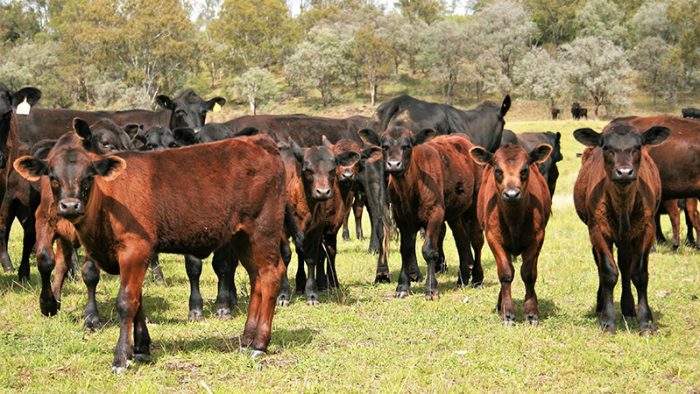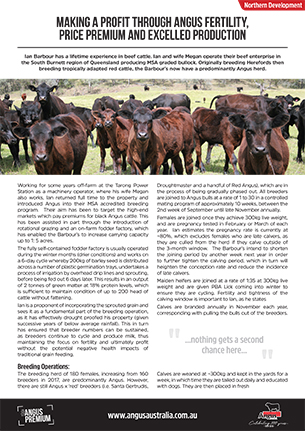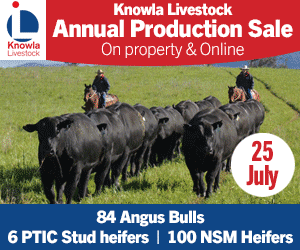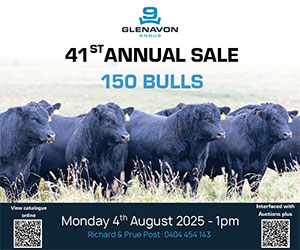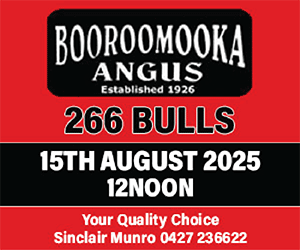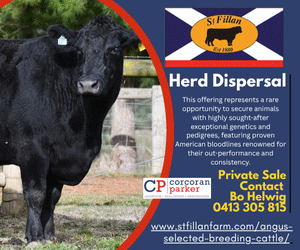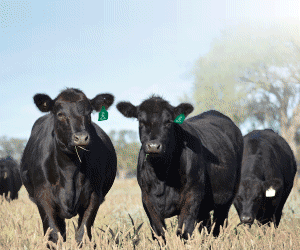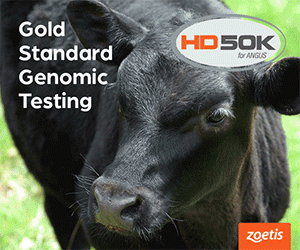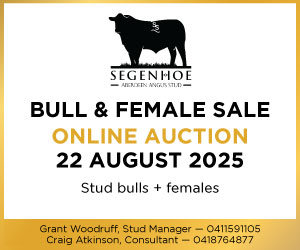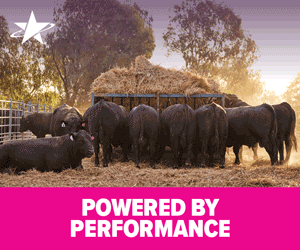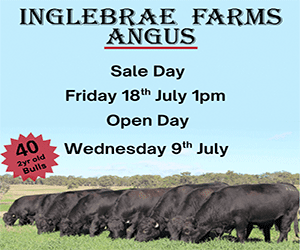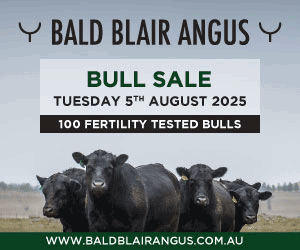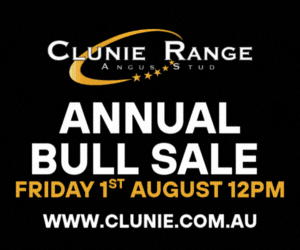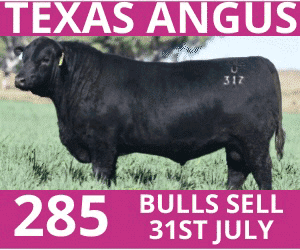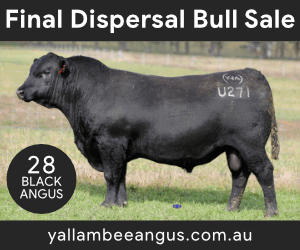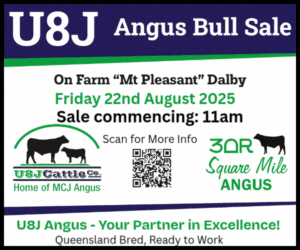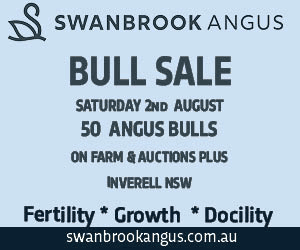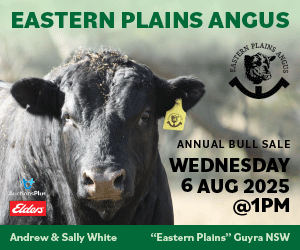Making a profit through Angus fertility, price premium and excelled production
Ian Barbour has known beef cattle his entire life. Ian and his family operated their beef enterprise in the South Burnett region of Queensland growing progeny out to bullock weights, originally with a Hereford based herd, before moving into tropically adapted cattle such as Santa Gertrudis and Droughtmaster.
Working for some years off-farm at the Tarong Power Station as a machinery operator, where his wife Megan also works, Ian returned full time to the property and introduced Angus into their MSA accredited breeding program. Their aim has been to target the high-end markets which pay premiums for black Angus cattle. This has been assisted in part through the introduction of rotational grazing and an on-farm fodder factory, which has enabled the Barbour’s to increase carrying capacity up to 1: 5 acres.
The fully self-contained fodder factory is usually operated during the winter months (drier conditions) and works on a 6-day cycle whereby 200kg of barley seed is distributed across a number of plastic germination trays, undertakes a process of irrigation by overhead drip lines and sprouting, before being fed out 6 days later. This results in an output of 2 tonnes of green matter at 18% protein levels, which is sufficient to maintain condition of up to 200 head of cattle without fattening.
Ian is a proponent of incorporating the sprouted grain and sees it as a fundamental part of the breeding operation, as it has effectively drought proofed his property (given successive years of below average rainfall). This in turn has ensured that breeder numbers can be sustained, as breeders continue to cycle and produce milk, thus maintaining the focus on fertility and ultimately profit without the potential negative health impacts of traditional grain feeding.
Breeding Operations:
The breeding herd of 180 females, increasing from 160 breeders in 2017, are predominantly Angus. However, there are still Angus x ‘red’ breeders (i.e. Santa Gertrudis, Droughtmaster and a handful of Red Angus), which are in the process of being gradually phased out. All breeders are joined to Angus bulls at a rate of 1 to 30 in a controlled mating program of approximately 10 weeks, between the 2nd week of September until late November annually.
Females are joined once they achieve 300kg live weight, and are pregnancy tested in February or March of each year. Ian estimates the pregnancy rate is currently at ~80%, which excludes females who are late calvers, as they are culled from the herd if they calve outside of the 3-month window. The Barbour’s intend to shorten the joining period by another week next year in order to further tighten the calving period, which in turn will heighten the conception rate and reduce the incidence of late calvers.
Maiden heifers are joined at a rate of 1:35 at 300kg live weight and are given PBA Lick coming into winter to ensure they are cycling. Fertility and tightness of the calving window is important to Ian, as he states “…nothing gets a second chance here…”.
Calves are branded annually in November each year, corresponding with pulling the bulls out of the breeders. Calves are weaned at ~300kg and kept in the yards for a week, in which time they are tailed out daily and educated with dogs. They are then placed in fresh pasture before putting them onto a fresh crop of oats grown at “Hollypark”, where they put on approximately 1kg/day.
Bull selection & management:
Ian advises bulls must possess a good head, excellent temperament, pedigree, fertility and structural soundness, backed up by good figures. IMF EBVs feature strongly in his bull selection. Although it’s not yet part of any current grid pricing that Ian receives, he believes marbling will be a trait that will be commonplace in most beef markets in the future.
Newly purchased bulls are usually kept in the yards for a couple of days before being introduced into the remainder of the bulls prior to joining. In that time, they are fed good quality hay, and given MULTIMIN ®, 7 in 1 and vibrio injections.
Marketing:
Each April and May, 50 cull heifers are sold direct off their dams into the Dalby saleyards where they are highly sought after. This is done not only to assist in cash-flow, but also to assist in eliminating feed and management costs and labour of animals that would never have been retained as breeders.
Steers are grown out and finished between 500 – 600kg live weight before being marketed to JBS Dinmore while they are often still only milk tooth. Alternatively, they have also been sold as ~400kg feeder steers to Darling Downs feedlots or direct to Brisbane Valley Meats. Cull cows are either marketed direct to Dinmore or through Dalby saleyards.
Regular kill sheet data reflects good IMF scores with progeny regularly achieving 3.6%. This has been a direct result of bull selection, with Ian advising purchased bulls to have averaged around 6% and one bull at 9% IMF. As the crossbred females are gradually phased out and the proportion of straight bred Angus breeders increase, Ian expects the average IMF score to gradually increase.
The Barbour’s outstanding MSA grass fed (no HGP) scores are a direct reflection of utilising Angus genetics and overall management. Their average MSA score of 62.28 sits well above the Wide Bay and Burnett regional average of 58.88 and just shy of the 63.54 benchmark top 5 % for the region. This has been achieved through careful selection of genetics, nutritional management and livestock husbandry resulting in heavier carcasses to the average (+10.7kg), lower ossification score of 150, AUS-MEAT marbling score of 1 and MSA Marbling score of 360.
Ultimately, the consistent nutritional plain assisted through the fodder factory and rotational grazing, combined with stringent genetic selection and tough stance on fertility and performance have all contributed to the Barbour’s producing a highly sought after premium product, which commands premium prices.
This year, a line of steers sold by Ian and Megan Barbour weighing in at average 418kg achieved a price of $3.50/kg (live weight) delivered to Inglewood Queensland. The market at the same time was within the $2.80/kg – $2.90/kg range, demonstrating a premium of $0.60/kg.
Furthermore, Ian advises that even in the Dalby saleyards his cattle attract a premium of at least $0.15/kg to $0.20/kg above the same market.
Angus Australia acknowledges the funds provided by the Australian Government through the Meat & Livestock Australia Donor Company (MDC).
This resource was created as a result of a collaboration between Angus Australia and Meat & Livestock Australia Donor Company (MDC) (Project P.PSH.1063).

